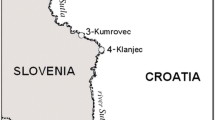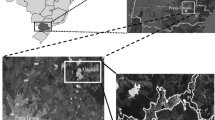Abstract
In the present study, essential and nonessential metal content and biomarker responses were investigated in the intestine of fish collected from the areas polluted by mining. Our objective was to determine metal and biomarker levels in tissue responsible for dietary intake, which is rarely studied in water pollution research. The study was conducted in the Bregalnica River, reference location, and in the Zletovska and Kriva Rivers (the Republic of North Macedonia), which are directly influenced by the active mines Zletovo and Toranica, respectively. Biological responses were analyzed in Vardar chub (Squalius vardarensis; Karaman, 1928), using for the first time intestinal cytosol as a potentially toxic cell fraction, since metal sensitivity is mostly associated with cytosol. Cytosolic metal levels were higher in fish under the influence of mining (Tl, Li, Cs, Mo, Sr, Cd, Rb, and Cu in the Zletovska River and Cr, Pb, and Se in the Kriva River compared to the Bregalnica River in both seasons). The same trend was evident for total proteins, biomarkers of general stress, and metallothioneins, biomarkers of metal exposure, indicating cellular disturbances in the intestine, the primary site of dietary metal uptake. The association of cytosolic Cu and Cd at all locations pointed to similar pathways and homeostasis of these metallothionein-binding metals. Comparison with other indicator tissues showed that metal concentrations were higher in the intestine of fish from mining-affected areas than in the liver and gills. In general, these results indicated the importance of dietary metal pathways, and cytosolic metal fraction in assessing pollution impacts in freshwater ecosystems.




Similar content being viewed by others
Availability of data and materials
The datasets used and/or analyzed during the current study are available from the corresponding author on reasonable request.
References
Adams SM (2002) Biological indicators of aquatic ecosystem stress. American Fisheries Society, Bethesda
Andres S, Ribeyre F, Tourencq JN, Boudou A (2000) Interspecific comparison of cadmium and zinc contamination in the organs of four fish species along a polymetallic pollution gradient (Lot River, France). Sci Total Environ 248(1):11–25
Barišić J, Dragun Z, Ramani S, Filipović Marijić V, Krasnići N, Čož-Rakovac R, Kostov V, Rebok K, Jordanova M (2015) Evaluation of histopathological alterations in the gills of Vardar chub (Squalius vardarensis Karaman) as an indicator of river pollution. Ecotox Environ Safe 118:158–166
Bury NR, Walker PA, Glover CN (2003) Nutritive metal uptake in teleost fish. J Exp Biol 206:11–23
Byrne P, Wood PJ, Reid I (2012) The impairment of river systems by metal mine contamination: a review including remediation options. Crit Rev Environ Sci Technol 42(19):2017–2077
Campbell PGC, Giguère A, Bonneris E, Hare L (2005) Cadmium-handling strategies in two chronically exposed indigenous freshwater organisms - the yellow perch (Perca flavescens) and the floater mollusc (Pyganodon grandis). Aquat Toxicol 72:83–97
Dallinger R, Kautzky H (1985) The importance of contaminated food for the uptake of heavy metals by rainbow trout (Salmo gairdneri): A field study. Oecologia 67:82–89
Dragun Z, Tepić N, Ramani S, Krasnići N, Filipović Marijić V, Valić D, Kapetanović D, Erk M, Rebok K, Kostov V, Jordanova M (2019) Mining waste as a cause of increased bioaccumulation of highly toxic metals in liver and gills of Vardar chub (Squalius vardarensis Karaman, 1928). Environ Pollut 247:564–576
Dragun Z, Raspor B, Podrug M (2007) The influence of the season and the biotic factors on the cytosolic metal concentrations in the gills of the European chub (Leuciscus cephalus L.). Chemosphere 69(6):911–919
Erk M, Ivanković D, Raspor B, Pavičić J (2002) Evaluation of different purification procedures for the electrochemical quantification of mussel metallothioneins. Talanta 57:1211–1218
Filipović Marijić V, Raspor B (2014) Relevance of biotic parameters in the assessment of the spatial distribution of gastrointestinal metal and protein levels during spawning period of European chub (Squalius cephalus L.). Environ Sci Pollut R 21(12):7596–7606
Filipović Marijić V, Raspor B (2010) The impact of fish spawning on metal and protein levels in gastrointestinal cytosol of indigenous European chub. Comp Biochem Phys C 152:133–138
Filipović Marijić V, Raspor B (2012) Site-specific gastrointestinal metal variability in relation to the gut content and fish age of indigenous European chub from the Sava River. Water Air Soil Poll 223:4769–4783
Giguère A, Campbell PGC, Hare L, McDonald DG, Rasmussen JB (2004) Influence of lake chemistry and fish age on cadmium, copper, and zinc concentrations in various organs of indigenous yellow perch (Perca flavescens). Can J Fish Aquat Sci 61:1702–1716
Handy RD, Sims DW, Giles A, Campbell HA, Musonda MM (1999) Metabolic trade-off between locomotion and detoxification for maintenance of blood chemistry and growth parameters by rainbow trout (Oncorhynchus mykiss) during chronic dietary exposure to copper. Aquac Toxicol 47(1):23–41
Jarić I, Višnjić-Jeftić Ž, Cvijanović G, Gačić Z, Lj J, Skorić S, Lenhardt M (2011) Determination of differential heavy metal and trace element accumulation in liver, gills, intestine and muscle of sterlet (Acipenser ruthenus) from the Danube River in Serbia by ICP-OES. Microchem J 98:77–81
Jordanova M, Rebok K, Dragun Z, Ramani S, Ivanova L, Kostov V, Valić D, Krasnići N, Filipović Marijić V, Kapetanović D (2016) Histopathology investigation on the Vardar chub (Squalius vardarensis) populations captured from the rivers impacted by mining activities. Ecotox Environ Safe 129:35–42
Jordanova M, Rebok K, Dragun Z, Ramani S, Ivanova L, Kostov V, Valić D, Krasnići N, Filipović Marijić V, Kapetanović D (2017) Effects of heavy metal pollution on pigmented macrophages in kidney of Vardar chub (Squalius vardarensis Karaman). Microsc Res Techniq 80(8):930–935
Koç HT, Erdoğan Z, Tinkci M, Treer T (2007) Age, growth and reproductive characteristics of chub, Leuciscus cephalus (L., 1758) in the İkizcetepeler dam lake (Balikesir), Turkey. J Appl Ichthyol 23(1):19–24
Koch M, Rotard W (2001) On the contribution of background sources to the heavy metal content of municipal sewage sludge. Water Sci Technol 43(2):67–74
Kraemer LD, Campbell PGC, Hare L (2006) Seasonal variations in hepatic Cd and Cu concentrations and in the sub-cellular distribution of these metals in juvenile yellow perch (Perca flavescens). Environ Pollut 142:313–325
Lapointe D, Couture P (2009) Influence of the route of exposure on the accumulation and subcellular distribution of nickel and thallium in juvenile fathead minnows (Pimephales promelas). Arch Environ Con Tox 57:571–580
Lowry OH, Rosebrough NJ, Farr AL, Randall RJ (1951) Protein measurement with the Folin Phenol reagent. J Biol Chem 193:265–275
Maia HMS, Maia CFQ, Pires DFC, Valente ACN (2006) Biology of the iberian chub (Squalius carolitertii) in an atlantic-type stream (river Lima basin-north Portugal). A preliminary approach. Limnetica 25(3):713–722
Mason AZ, Jenkins KD (1995) Metal detoxification in aquatic organisms. In: Tessier A, Turner DR (eds) Metal Speciation and Bioavailability in Aquatic Systems, 1st edn. John Wiley and Sons, UK, vol. 3, pp 479–608
Mijošek T, Filipović Marijić V, Dragun Z, Ivanković D, Krasnići N, Redžović Z, Erk M (2021) Intestine of invasive fish Prussian carp as a target organ in metal exposure assessment of the wastewater impacted freshwater ecosystem. Ecol Indic 122:107247
Miramand P, Lafaurie M, Fowler SW, Lemaire P, Guary JC, Bentley D (1991) Reproductive cycle and heavy metals in the organs of red mullet, Mullus barbatus (L), from the northwestern Mediterranean. Sci Total Environ 103:47–56
Olsson P-E, Gerpe M, Kling P (1999) Functional and regulatory aspects of teleost metallothionein. In: Klaassen CD (ed) Metallothionein IV. Birkhauser, Basel, pp 179–185
Ptashynski MD, Pedlar RM, Evans RE, Baron CL, Klaverkamp JF (2002) Toxicology of dietary nickel in lake whitefish (Coregonus clupeaformis). Aquat Toxicol 58:229–247
Ramani S, Dragun Z, Kapetanović D, Kostov V, Jordanova M, Erk M, Hajrulai-Musliu Z (2014) Surface water characterization of three rivers in the Pb/Zn mining region of north-eastern Macedonia. Arch Environ Con Tox 66(4):514–528
Raspor B, Paić M, Erk M (2001) Analysis of metallothioneins by the modified Brdička procedure. Talanta 55:109–115
Rätz H-J, Lloret J (2003) Variation in fish condition between Atlantic cod (Gadus morhua) stocks, the effect on their productivity and management implications. Fish Res 60:369–380
Sanders BM, Dyer SD (1994) Cellular stress response. Environ Toxicol Chem 13:1209–1210
Staniskiene B, Matusevicius P, Budreckiene R, Skibniewska KA (2006) Distribution of heavy metals in tissues of freshwater fish in Lithuania. Pol J Environ Stud 15:585–591
Stipaničev D, Dragun Z, Repec S, Rebok K, Jordanova M (2017) Broad spectrum screening of 463 organic contaminants in rivers in Macedonia. Ecotox Environ Safe 135:48–59
Sun L-T, Jeng S-S (1998) Comparative zinc concentrations in tissues of common carp and other aquatic organisms. Zool Stud 37:184–190
Sures B, Siddall R (1999) Pomphorhynchus laevis: the intestinal acanthocephalan as a lead sink for its fish host, chub (Leuciscus cephalus). Exp Parasitol 93:66–72
Szpunar J (2005) Advances in analytical methodology for bioinorganic speciation analysis: metallomics, metalloproteomics and heteroatom-tagged proteomics and metabolomics. Analyst 130:442–465
Türkmen M, Halìloğlu İ, Erdoğan O (1999) The growth and reproduction characteristics of chub Leuciscus cephalus orientalis (Nordmann, 1840) Living in the River Aras. Turk J Zool 23:355–364
Ünlü E, Akba O, Sevim S, Gümgüm B (1996) Heavy metal levels in mullet, Liza abu (Heckel, 1843) (Mugilidae) from the Tigris River, Turkey. Fresen Environ Bull 5:107–112
Urien N, Cooper S, Caron A, Sonnenberg H, Rozon-Ramilo L, Campbell PCG (2018) Subcellular partitioning of metals and metalloids (As, Cd, Cu, Se and Zn) in liver and gonads of wild white suckers (Catostomus commersonii) collected downstream from a mining operation. Aquat Toxicol 202:105–116
Voets J, Redeker ES, Blust R, Bervoets L (2009) Differences in metal sequestration between zebra mussels form clean and polluted field locations. Aquat Toxicol 93:53–60
Wallace WG, Lee B-G, Luoma SN (2003) Subcellular compartmentalization of Cd and Zn in two bivalves. I. Significance of metal sensitive fractions (MSF) and biologically detoxified metal (BDM). Mar Eco-Prog Ser 249:183–197
Watanabe T, Kiron V, Satoh S (1997) Trace minerals in fish nutrition. Aquaculture 151:185–207
Wen-Xiong W (2013) Dietary toxicity of metals in aquatic animals: Recent studies and perspectives. Chinese Sci Bull 58(2):203–213
Acknowledgements
The authors are grateful to Dr. Nevenka Mikac for the opportunity to perform metal measurements on HR ICP-MS.
Funding
This research was funded by the Ministry of Science, Education and Sport of the Republic of Croatia (projects No. 098–0982934-2721 and 098–1782739-2749). The sampling was carried out as a part of two Croatian-Macedonian bilateral projects: “The assessment of availability and effects of metals on fish in the rivers under the impact of mining activities” and “Bacterial and parasitical communities of chub as indicators of the status of environment exposed to mining activities.”
Author information
Authors and Affiliations
Contributions
Vlatka Filipović Marijić: conceptualization, validation, formal analysis, investigation, writing—original draft, writing—review and editing, and visualization. Nesrete Krasnići: formal analysis and investigation. Damir Valić: formal analysis and investigation. Damir Kapetanović: formal analysis and investigation. Irena Vardić Smrzlić: investigation. Maja Jordanova: formal analysis and investigation. Katerina Rebok: formal analysis and investigation. Sheriban Ramani: formal analysis and investigation. Vasil Kostov: formal analysis and investigation. Rodne Nastova: investigation. Zrinka Dragun: conceptualization, formal analysis, investigation, writing—review and editing, and project administration. All authors read and approved the final manuscript.
Corresponding author
Ethics declarations
Ethical approval
Fish were sampled by electrofishing according to the standard CEN EN 14011:2003 and anesthetized and sacrificed according to the Ordinance on the protection of animals used for scientific purposes. Laboratory for Biological Effects of Metals is a laboratory for fish sacrifice and work with fish bodies, organs and tissues, authorized by the Ministry of Agriculture, Veterinary and Food Safety Department (license number: HR-POK-025).
Consent to participate
Not applicable.
Consent for publication
Not applicable.
Competing Interests
The authors declare no competing interests.
Additional information
Responsible Editor: Bruno Nunes
Publisher's note
Springer Nature remains neutral with regard to jurisdictional claims in published maps and institutional affiliations.
Rights and permissions
Springer Nature or its licensor (e.g. a society or other partner) holds exclusive rights to this article under a publishing agreement with the author(s) or other rightsholder(s); author self-archiving of the accepted manuscript version of this article is solely governed by the terms of such publishing agreement and applicable law.
About this article
Cite this article
Filipović Marijić, V., Krasnići, N., Valić, D. et al. Pollution impact on metal and biomarker responses in intestinal cytosol of freshwater fish. Environ Sci Pollut Res 30, 63510–63521 (2023). https://doi.org/10.1007/s11356-023-26844-2
Received:
Accepted:
Published:
Issue Date:
DOI: https://doi.org/10.1007/s11356-023-26844-2




